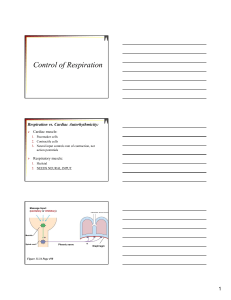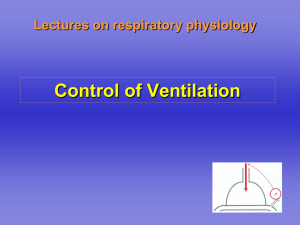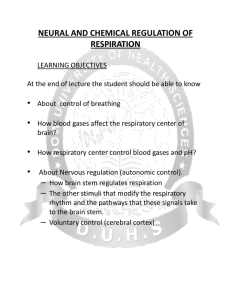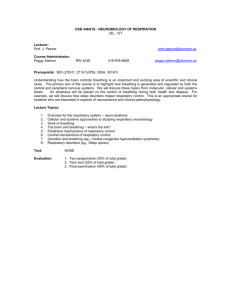Respiratory Center
advertisement
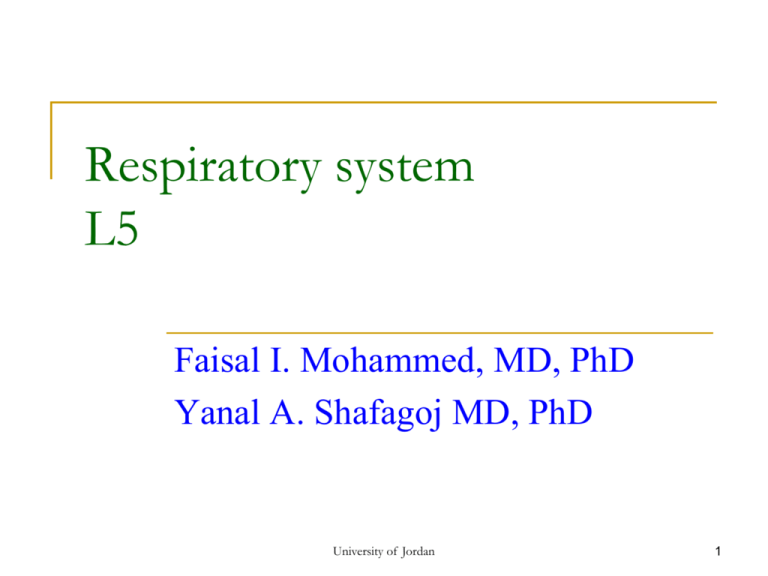
Respiratory system L5 Faisal I. Mohammed, MD, PhD Yanal A. Shafagoj MD, PhD University of Jordan 1 Control of Breathing….Introduction Q: What the controller system is going to do? A: Homeostasis of O2, CO2, H+ Q: How? A: by: Hyperventilation or hypoventilation Q: What is the feedback system? A: ↓ PaCO2, ↑PaCO2, ↓ PaO2 (below 60 mmHg), ↓ H+, and finally ↑H+ Note: ↑PaO2 has almost no effect on the controller system Regulation of Respiration ….Introduction • Sensors – • Central controller – • gather information integrate signals Effectors – Respiratory muscles How alveolar ventilation VA affects P O2 and P CO2 A A PAO2 depends on : 1. O2 delivery to alveoli (Alveolar Ventilation VA). 2. Rate of O2 absorption to blood (O2 Consumption VO2) PAO2 (VA/VO2) HYPERVENTILATION is when alveolar ventilation is more than CO2 production decrease PaCO2 HYPOVENTILATION is when alveolar ventilation is LESS than CO2 production increase PaCO2 PACO2 = (VO2/VA)* K K”= constant (= 0.863 mmHg. lit/ml). If ventilation is doubled then PCO2 is ½ If ventilation is halved then PCO2 is doubled…keeping CO2 production constant.....See the two graphs in the next two slide. Partial pressure of oxygen in alveoli 160 140 120 Metabolic rate 100 Po2 250 ml/min 80 1000 ml/min 60 40 20 0 0 5 10 15 20 25 30 Alveolar Ventilation Copyright © 2011 by Saunders, an imprint of Elsevier Inc. Partial pressure of CO2 in alveoli 200 160 Metabolic rate 120 200 ml/min Pco2 800 ml/min 80 40 0 2 5 10 15 20 25 30 Alveolar Ventilation Copyright © 2011 by Saunders, an imprint of Elsevier Inc. Objectives Describe the respiratory center Compare and contrast the effect of carbon dioxide and oxygen on the chemosensitive area Explain the role of peripheral chemoreceptors Describe how rate and depth are controlled Summarize the process of control of respiration REGULATION OF PULMONARY FUNCTION Respiratory control centers: the main integrators controlling the nerves that affect the inspiratory and expiratory muscles are located in the brainstem Medullary rhythmicity center: generates the basic rhythm of the respiratory cycle Consists of two interconnected control centers Inspiratory center stimulates inspiration Expiratory center stimulates expiration University of Jordan 8 REGULATION OF PULMONARY FUNCTION (cont.) The basic breathing rhythm can be altered by different inputs to the medullary rhythmicity center Input from the apneustic center in the pons stimulates the inspiratory center to increase the length and depth of inspiration Pneumotaxic center in the pons inhibits the apneustic center and inspiratory center to prevent overinflation of the lungs University of Jordan 9 University of Jordan 10 A. Location of Respiratory Centers & Control Units 1. Medullary Respiratory Centers a. Inspiratory Area - DRG - dorsal respiratory group neurons b. Expiratory Area - VRG - ventral respiratory group neurons 2. Pontine Centers: a. Pneumotaxic Center - located in upper pons (“off switch”) b. Apneustic Center - located in lower pons (prevents turn-off) 3. Pulmonary Receptors a. pulmonary stretch receptors (Hering-Breuer reflex) b. other receptors?? B. Control of Respiratory Activity 1. Central or Medullary Chemoreceptors 2. Peripheral Chemoreceptors 3. Interaction between Central and Peripheral Chemoreceptors. 4. Cortical Factors THE RESPIRATORY CENTER It is a loose collection of inspiratory and expiratory neurons situated in the medulla oblongata of the brain stem. Is not a discrete identifiable center in the strict anatomical sense. When inspiratory neurons are active, expiratory neurons are inhibited and vise versa. Brain Stem Respiratory Centers Neurons in the reticular formation of the medulla oblongata form the rhythmicity center: Controls automatic breathing. Consists of interacting neurons that fire either during inspiration (I neurons) or expiration (E neurons). Insert fig. 16.25 Respiratory Center Figure 41-1 Chemoreceptors 2 groups of chemoreceptors that monitor changes in blood PCO2, PO2, and pH. Central: Medulla…chemosensiti ve area…sensitive to H+ Peripheral: Carotid and aortic bodies. Control breathing indirectly via sensory nerve fibers to the Insert fig. 16.27 Chemoreceptor Control Central chemoreceptors: More sensitive to changes in arterial PC02 through H+ H20 + CO2 H2C03 H+ H+ cannot cross the blood brain barrier. C02 can cross the blood brain barrier and will form H2C03. Lowers pH of CSF fasters than it lowers blood pH Directly stimulates central chemoreceptors. Peripheral Chemoreceptors nerve impulses • Carotid body-bifurcation of the carotids –responds to oxygen (PO2<60 mmHg) –-responds to carbon dioxide and hydrogen ion…one seventh of –The central respons but 5 times faster 800 600 400 200 0 0 200 400 600 PO 2 Copyright © 2011 by Saunders, an imprint of Elsevier Inc. University of Jordan 18 Brain Stem Respiratory Centers Neurons in the reticular formation of the medulla oblongata form the rhythmicity center: Controls automatic breathing. Consists of interacting neurons that fire either during inspiration (I neurons) or expiration (E neurons). Insert fig. 16.25 University of Jordan 20 REGULATION OF PULMONARY FUNCTION (cont.) Factors that influence breathing: sensors from the nervous system provide feedback to the medullary rhythmicity center Changes in the PO2, PCO2, and pH of arterial blood influence the medullary rhythmicity area PCO2 acts on central chemoreceptors in the medulla—if it increases, the result is faster breathing; if it decreases, the result is slower breathing A decrease in blood pH stimulates peripheral chemoreceptors in the carotid and aortic bodies and, even more so, stimulates the central chemoreceptors (because they are surrounded by unbuffered fluid) (Figure 24-32) Arterial blood PO2 presumably has little influence if it stays above a certain level Low arterial blood PO2 is the main stimulus for breathing in chronic smokers University of Jordan 22 Controls of rate and depth of respiration Arterial PO2 When PO2 is below 60mmHg, ventilation increases Arterial PCO2 It is the most important regulator of ventilation, small increases in PCO2, greatly increases ventilation Arterial pH As hydrogen ions increase, alveolar ventilation increases, but hydrogen ions cannot diffuse into CSF as well as CO2 Central (medullary) Chemoreceptors (mechanisms) the H+ (CO2) sensors blood here cerebrospinal fluid between brain here H+ Peripheral Chemoreceptors University of Jordan 25 A Summary of Chemoreceptor Reflexes Brain Stem Respiratory Centers (continued) I neurons project to, and stimulate spinal motor neurons that innervate respiratory muscles. Expiration is a passive process that occurs when the I neurons are inhibited. Activity varies in a reciprocal way. Rhythmicity Center I neurons located primarily in dorsal respiratory group (DRG): Regulate activity of phrenic nerve. Project to and stimulate spinal interneurons that innervate respiratory muscles. E neurons located in ventral respiratory group (VRG): Passive process. Controls motor neurons to the internal intercostal muscles. Activity of E neurons inhibit I neurons. Rhythmicity of I and E neurons may be due to pacemaker neurons. Pons Respiratory Centers Activities of medullary rhythmicity center is influenced by pons. Apneustic center: Promotes inspiration by stimulating the I neurons in the medulla. Pneumotaxic center: Antagonizes the apneustic center. Inhibits inspiration. Chemoreceptors 2 groups of chemoreceptors that monitor changes in blood PC0 , P0 , and pH. Central: 2 2 Medulla. Peripheral: Carotid and aortic bodies. Control breathing indirectly via sensory nerve fibers to the medulla (X, IX). Insert fig. 16.27 Effects of Blood PC0 and pH on Ventilation 2 Chemoreceptor input modifies the rate and depth of breathing. Oxygen content of blood decreases more slowly because of the large “reservoir” of oxygen attached to hemoglobin. Chemoreceptors are more sensitive to changes in PC02. H20 + C02 H2C03 H+ + HC03Rate and depth of ventilation adjusted to maintain arterial PC02 of 40 mm Hg. Chemoreceptor Control Central chemoreceptors: More sensitive to changes in arterial PC02. H20 + C02 H2C03 H+ H+ cannot cross the blood brain barrier. C02 can cross the blood brain barrier and will form H2C03. Lowers pH of CSF. Directly stimulates central chemoreceptors. Chemoreceptor Control (continued) Peripheral chemoreceptors: Are not stimulated directly by changes in arterial PC02. H20 + C02 H2C03 H+ + HCO3Stimulated by rise in [H+] of arterial blood. Increased [H+] stimulates peripheral chemoreceptors. Chemoreceptor Control of Breathing Insert fig. 16.29 Effects of Blood P0 on Ventilation 2 Blood P0 affected by breathing indirectly. 2 Influences chemoreceptor sensitivity to changes in PC0 . 2 Hypoxic drive: Emphysema blunts the chemoreceptor response to PC0 . Choroid plexus secrete more HC03- into CSF, buffering the fall in CSF pH. Abnormally high PC0 enhances sensitivity of carotid bodies to fall in P0 . 2 2 2 Effects of Pulmonary Receptors on Ventilation Lungs contain receptors that influence the brain stem respiratory control centers via sensory fibers in vagus. Unmyelinated C fibers can be stimulated by: Capsaicin: Produces apnea followed by rapid, shallow breathing. Histamine and bradykinin: Released in response to noxious agents. Irritant receptors are rapidly adaptive receptors. Hering-Breuer reflex: Pulmonary stretch receptors activated during inspiration. Inhibits respiratory centers to prevent undue tension on lungs. Pulmonary Disorders Dyspnea: Shortness of breath. COPD (chronic obstructive pulmonary disease): Asthma: Obstructive air flow through bronchioles. Caused by inflammation and mucus secretion. Inflammation contributes to increased airway responsiveness to agents that promote bronchial constriction. IgE, exercise. Pulmonary Disorders (continued) Emphysema: Alveolar tissue is destroyed. Chronic progressive condition that reduces surface area for gas exchange. Decreases ability of bronchioles to remain open during expiration. Cigarette smoking stimulates macrophages and leukocytes to secrete protein digesting enzymes that destroy tissue. Pulmonary fibrosis: Normal structure of lungs disrupted by accumulation of fibrous connective tissue proteins. Anthracosis. Disorders Caused by High Partial Pressures of Gases Nitrogen narcosis: At sea level nitrogen is physiologically inert. Under hyperbaric conditions: Nitrogen dissolves slowly. Can have deleterious effects. Resembles alcohol intoxication. Decompression sickness: Amount of nitrogen dissolved in blood as a diver ascends decreases due to a decrease in PN . 2 If occurs rapidly, bubbles of nitrogen gas can form in tissues and enter the blood. Block small blood vessels producing the “bends.” RESPONSES TO CHANGE IN RESPIRATORY GASES Hypoxia - O2 deficiency at the tissue level. There could be several causes. 1. Hypoxic-hypoxia (PO2 of arterial blood is reduced). e.g., breathing O2-poor gas or at reduced atmospheric pressures. When PO2 of inspired air falls to about 60-70 mmHg there is loss of consciousness (alv. PO2 ~35-40 mm Hg). At sea level when breathing in an environment with 10% or less O2, you are in trouble. With altitude, composition of air remains about same but there are pressure changes. Delayed effects of altitude Acclimatization 2. Anemic-hypoxia Essentially low Hb content. Also in CO poisoning, effective Hb content is reduced by HbCO complexing. 3. Stagnant-hypoxia Hypoxia due to circulation that is so slow that tissue does not receive its necessary "flow" of O2. Shock, congestive heart failure (or localized restriction) can lead to damage of important organs. 4. Histotoxic-hypoxia Inhibition of tissue oxidative processes by poisons. e.g., Cyanide poisoning - combines with cytochrome oxidase preventing O2 from serving as the ultimate electron acceptor. Thank You University of Jordan 42

